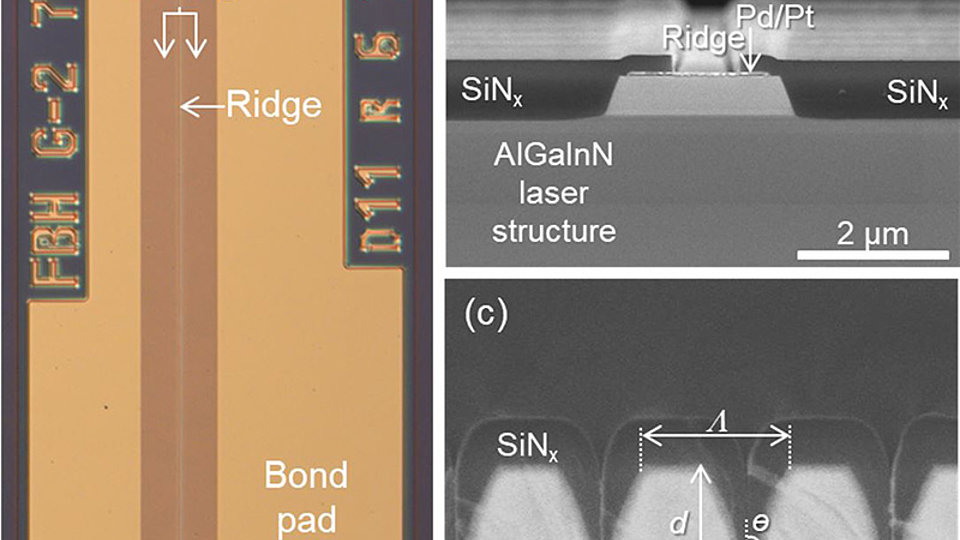GaN-based DFB laser diodes with 10th-order laterally coupled surface gratings
Fig. 1. Plan-view microscopic image of an LC-DFB LD (a); cross section SEM images of an LC-DFB LD parallel to the laser facet (b) and of the V-shaped gratings perpendicular to the laser facet (c).
Distributed feedback (DFB) laser diodes (LDs) emitting in the blue-violet spectral region are promising light sources for spectroscopy, atomic clocks, and medical applications, requiring a stable emission wavelength and a narrow linewidth.
However, the realization of low-order (1st, 2nd, or 3rd-order) Bragg gratings is technically challenging due to the short emission wavelength and the resulting small dimensions of the gratings. To overcome this difficulty, the concept of 10th-order laterally coupled (LC) surface Bragg gratings with V-shaped grooves was recently proposed by FBH. Within the Joint Lab GaN Optoelectronics an optically pumped LC-DFB laser based on GaN was demonstrated [1].
The work was continued by fabricating LC-DFB LDs using the process technology for the gratings in a conventional ride waveguide Fabry-Pérot (RW-FP) laser diode process. The V-shaped gratings with a period of L = 802 nm, an etch depth of d = 600 nm, a slant angle (ө) of 20° and a width of the groove tip of around 10 nm were defined alongside a 2 µm wide and 600 µm long ridge on a GaN-based laser structure using i-line stepper lithography and inductively coupled plasma etching (see Fig. 1). Under pulsed operation the LC-DFB LDs show a single peak emission at 404.5 nm with a side mode suppression ratio of 23 dB, a spectrometer limited full width at half maximum of 0.04 nm, and an output power of about 46 mW at 100 mA (see Fig. 2). In contrast, the emission spectrum of conventional RW-FP LDs fabricated for comparison consisted of multiple peaks independent of the injection current.
The results clearly show that the high-order laterally coupled gratings act as wavelength-selective elements. Moreover, the shift of the lasing wavelength with temperature of the LC-DFB LDs was around three times smaller than that of RW-FP LDs (see Fig. 3). The low sensitivity of LC-DFB LDs to temperature results from the coupling of the optical mode to the grating, i.e. the shift of the emission wavelength mainly emerges from the temperature dependence of the effective refractive index of the optical mode rather than the shift of the gain maximum. Moreover, the LC-DFB LDs showed a clear single peak emission for the entire temperature range from 22 °C to 45 °C.
In conclusion, the concept of DFB-LDs using high-order laterally coupled surface gratings was successfully demonstrated in the blue-violet spectral region. Further work will focus on the reliability of the devices.
Publication
J. H. Kang, M. Martens, H. Wenzel, V. Hoffmann, W. John, S. Einfeldt, T. Wernicke, and M. Kneissl, “Optically pumped DFB lasers based on GaN using 10th-order laterally coupled surface gratings“, IEEE Photonics Technology Letters 29, 138 (2017).


